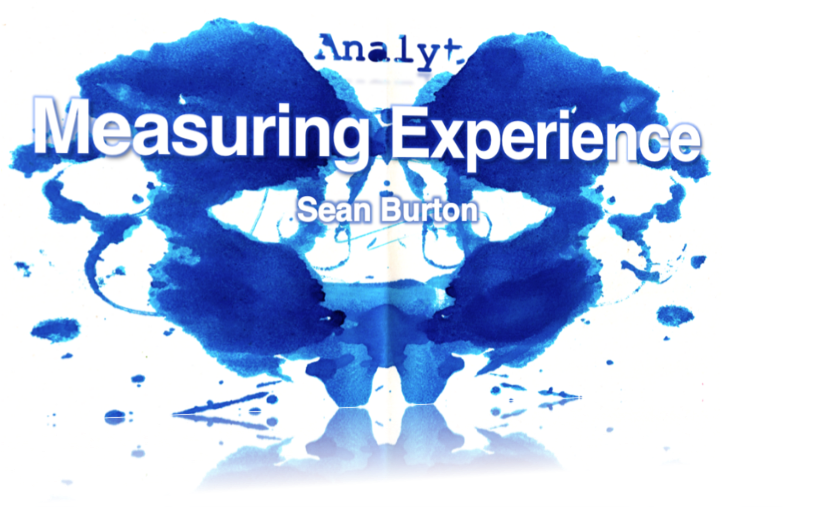Customer First, not Mobile First
Updated: 07 Aug 2019
The week before last I was speaking at Digital Union's UX Day 2014 about Measuring Experience.
There were some great questions from the audience and from the chair Ben Mawhinney, and one that caught my attention related to the current trend of designing for mobile devices as your main focus, called 'Mobile First' design.
I made the point that we should design for the "customer first, not mobile first", and that the only way to do that is to understand and listen to your customer needs. This was picked up in an article by Graham Charlton from eConsultancy and so I felt compelled to expand on the topic with my own blog article.
Full room at #uxday @digiunion @analytdata great talk learning a lot pic.twitter.com/SkpYO3B6uY
— Carri Cunliffe (@Carriw) October 9, 2014Mobile is obviously a vital part of web site design as many web sites now received more than half of their traffic via mobile devices. However, the customers are still the same. You need to ensure that your site is designed to meet their needs period, not their needs on a specific device.
For many years I've worked alongside UX colleagues who have championed User Centred Design methodologies. Whilst a solid metholodology, they tend to focus on small UX lab sessions with 8-10 people and so have also made me slightly nervous about their ability to extrapolate to a wide population size.
For me, this is where measurement strategies come into their own. They offer the ability to inform, validate, and scale UX lab findings.
For example, I'd advocate the following design process:
- Initial discover phase
- Customer feedback from web site
- Email & Customer Services feedback
- Recruitment for user group or panel
- use web analytics and operational data to find core bottle-necks & pain points
- Initial concept paper design workshops
- trial basic paper designs with users
- identify core high-value or high-adovate customers and invite to review designs
- Iterate fast based on feedback - no pre-conceived ideas & anything goes
- Rationalise
- Time for the real-world.
- Take your designs and distil to core concepts / features / functions and create a design ethos
- Get the technical and customer services teams involved. How difficult are the design concepts to deliver, and more importantly, how difficult are they to maintain?
- define and communicate the goals of the design - what are you trying to acheieve. It is vital that everyone across the organisations is on the same page and on-board with the concept. If not listen, respond, and adapt as needed! If your staff aren't on-board, or feel threatened, with the changes your making then they're not going to give your customers the best experience. Remembers customers don't see different channels or different teams - they see your brand. A bad experience in one channels will impact their perception of all channels.
- Create customer journeys & dynamic personnas
- categorise/segment your customers into a set of groups based on key behavioural or demographic attributes - ideally you should move towards personalisation, but baby steps are better than no steps!
- try to bring your customer segments to life, by creating a set of personnas - exampler users with key attributes/characteristics that match core aspects of your real customers.
- now create a series of customer journeys around your core goals and make sure they work for each of your customer groups
- Remember that a customer journey is wider that just a set of steps in a process. A journey should include use cases starting with how and why the person arrives at your site. Do they complete the process in one go? Will they get distracted and leave the site? Will the need to come back later? Can they complete via a different channel, e.g. call centre or in-store?
- Create a measurement framework
- Define success measures based on the goals of the design and your organisations - what does good look like?
- develop these measures into a Metrics Map, containing Key Performance Indicators and associated contextual metrics. For each metric, define why it's needed, how it's measured, who owns it, and what action to take should it change.
- You may find that you're not currently able to measure everything need and so take the time to plan out a implementation roadmap that's practical.
- Dashboards are a great way to visualise your KPIs and should form part of your wider measurement strategy.
- Launch, Test, and Iterate
- Through out your design process, get your customers involved to see what they think.
- Launch with less features, but with more polish. Take the time to really nail down each new feature and test the edge cases. Constantly use the customer journeys/personnas during your design and marketing activities to hone the end-user experience.
- implement a customer feedback programme to capture and measure the actual experiences of your customers - ensure that this is a cross-channel programme, with input from the web site, social media, customer services, retails, etc.
- have regular internal workshops to discuss the findings of the programme and how to implement the suggestions - make sure things actually happen!
- Keep your customers informed, ideally personally, but a regular, "you said, we did" section in your newsletter or via social channels is a good start.

Do you manage to get much take-up of personas? It was a subject which came up in discussions at Superweek this year. So I conducted a quick poll during my session. I don't know how many in the room - maybe 100 or so -- but only about 4 or 5 of us were actually using them. Not sure why!


Tim, thanks for commenting!
I've found that many of the clients I've worked with have had some form of persona, but they are often out of date, badly designed, or not actively used. Personas tend to get a bad press for this reason - hence why I mention 'Dynamic Personas', which ideally are updated on a semi-regular basis. The best implementations I've seen are where clients have the personas on large cardboard cut outs along with their details - especially with a name! This really helped staff to relate to the personas and resulted in people from across the business asking about them in meetings, e.g. what would 'Fred' think about that design?
In my last company, Seren, we used to include data attributes to the Personas too. This allowed us to build analytics reports based on segments related to the Personas, e.g. "How many Pete's resonded to that email campaign?" - there's clearly a bit of 'fuzzy' attribution, but the intention was to help bring the personas alive and to help drive the principles of data-driven decision making to people outside of the analytics team.


Add new comment (subject to moderation):
| Full name: |  |
| Email: |  |
| Website: optional |
|
| Article Rating: optional |
|
| Comment: optional |
|
 |
|
| Type the text shown in the image above: | |
|
|


 @analytdata
@analytdata facebook
facebook LinkedIn
LinkedIn